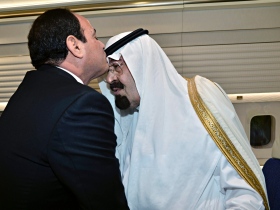Between Sebsi and Sisi
Mshari Al-Zaydi/Thursday, 25 Dec, 2014
There are many exciting similarities between Tunisia and Egypt. The two countries have followed almost exactly the same course, from the chaotic bedlam of the Arab Spring to the almost similar surnames of their current presidents, Abdel-Fattah El-Sisi and Beji Caid El-Sebsi.
In Tunisia, street vendor Mohamed Bouazizi emerged as an icon of public anger and a talisman of popular revolution against the regime and the state. As for Egypt, Khaled Said, the young man who died at the hands of the police in Alexandria served as the objective and symbolic counterpart to Bouazizi. The names of both men became expressions of the people’s will.
It was said that the Muslim Brotherhood, the traditional enemy of state in both Egypt and Tunisia, had no role in the public protests that erupted in 2011. We all remember that even Ennahda leader Rachid Ghanouchi acknowledged that the revolution was staged by the Tunisian people before his Islamist group could join rebel ranks. This was also the case in Egypt where the Brotherhood later entered protest squares and joined the revolutionaries; or at least that is the picture they wanted others to see, dislodging claims that the original revolution had been “civilian and secularist.”
In both countries, Muslim Brotherhood affiliated parties secured the lion’s share of parliamentary seats in the first post-revolution elections. Egypt’s Freedom and Justice Party and Tunisia’s Ennahda—both affiliated with the Brotherhood—formed the cornerstone of the post-revolutionary political scene. They were joined by civilian forces, such as the left-wing Moncef Al-Marzouki in Tunisia and Ayman Nour in Egypt, who acted as a mere façade to what was going on behind the scene. The same goes for some romantic revolutionary youth who sought to enter the political arena.
In Egypt and Tunisia, the Brotherhood failed to “administer” the state and run people’s affairs, preoccupying themselves with marginal petty political battles. To be honest, Ennahda’s performance in Tunisia was far more judicious and realistic than that of the Freedom and Justice party in Egypt who, due to their political immaturity, pounced greedily on power and than set about following a policy based solely on political intimidation.
Tunisia’s Brotherhood avoided the fate of their Egyptian counterparts by relinquishing some of their political powers when they realized that they were facing an inevitable wave of change. As a result, they avoided the tsunami of public resentment, saving what they could of the spoils of power, unlike the parent group in Egypt.
The political scene in Egypt remained confused until Field Marshal Sisi came to power on the back of an overwhelming public mandate and he has been able to secure many successes in just a short period of time. In Tunisia, Sebsi’s Nidaa Tounes have now completely eclipsed Ennahda.
While Sisi has been described as Gamal Abdel-Nasser’s successor, Sibsi claims to be the heir of Habib Bourguiba, the father of the modern Tunisian state.
I do not claim that the picture in both countries is identical. There are many clear and obvious differences, but these serve only to highlight the similarities. Contrary to Muslim Brotherhood propaganda in both countries, the latest shift does not mark a return to the former regimes of Hosni Mubarak and Zine Al-Abidine Ben Ali. In fact, the change in both countries represents a giant leap forward and, most importantly, quashes the century-long illusion that the Muslim Brotherhood represent the salvation of the state.
President Sisi always affirmed that there would be no return to Mubarak’s regime or the Brotherhood state. While the newly-elected President Sebsi claims there will be no going back to Ben Ali’s regime or fundamentalist rule in Tunisia.
Now is the moment for the state. Perhaps everything that happened in Egypt and Tunisia was necessary chance to inject new blood into the political leadership of both countries. The state remains, first and foremost, the top priority.






















